Introduction
Coat of Arms
A coat of arms is a heraldic visual design on an escutcheon (i.e., shield), surcoat, or tabard. The coat of arms on an escutcheon forms the central element of the full heraldic achievement which in its whole consists of: shield, supporters, crest, and motto. A coat of arms is traditionally unique to an individual person, family, state, organization or corporation.
Rolls of arms are collections of many coats of arms, and since the early Modern Age centuries they have been a source of information for public showing and tracing the membership of a noble family, and therefore its genealogy across time.
There is no more enduring symbol of heritage and nobility than 'the Coat of Arms'. Of course, heralds did not know, or even suspect, that seven or eight hundred years after their creation discussions would still be taking place about their representation, authenticity, composition, and so on. Heraldry endures and so far at least, nothing has been invented to replace it. The practice of 'inheritance by primogeniture' means there is a relatively miniscule number of people who are actually entitled to bear a coat of arms, for example, estimates of around 40,000 in England.
The king of beasts
Lion (heraldry)
The lion is a common charge in heraldry. It traditionally symbolises courage, nobility, royalty, strength, stateliness and valour, because historically the lion has been regarded as the "king of beasts". The lion also carries Judeo-Christian symbolism. The Lion of Judah stands in the coat of arms of Jerusalem. Similar-looking lions can be found elsewhere, such as in the coat of arms of the Swedish royal House of Bjelbo, from there in turn derived into the coat of arms of Finland, formerly belonging to Sweden.
Lions in British heraldry
"The lion has become a major motif for Britain because of its early uses by King Henry I of England and popularization by Richard the Lionheart in the third crusade. The influence of the Lion being used as a symbol or motif can be traced as far back as the Neolithic period.
King Henry I of England was the first king of England known to use a heraldic design: a signet ring with a lion engraved on it. The design would be altered in later generations to form the Royal Arms of England. Henry was said to have given a badge decorated with a lion to his son-in-law Geoffrey Plantagenet, Count of Anjou. Heraldry is thought to have becoming popular among the knights on the first and second crusades, along with the idea of chivalry. One example of this is the seal of John Mundegumri (1175), which bears a single fleur-de-lys. Prior to the 16th century, there was no regulation on the use of arms in England.
The lion as a heraldic charge is present from the very earliest development of heraldry in the 12th century. One of the earliest known examples of armory as it subsequently came to be practiced decorates the tomb of Geoffrey Plantagenet, Count of Anjou, who died in 1151. An enamel, probably commissioned by Geoffrey's widow between 1155 and 1160, depicts him carrying a blue shield with golden lions rampant and wearing a blue helmet adorned with another lion. A chronicle dated to about 1175 states that Geoffrey was given a badge of a gold lion when he was knighted by his father-in-law, Henry I, in 1128."
Category: Argent a lion sable
The Lion Rampant: arms (lionrampant.org.uk)
Note: Many broken links. Saved arms page as local copy.
Why is this important?
In the book "The Norman People and their existing descendants in the British dominions and the United States of America", 1874 (Author: Name not stated), we find reference to:
"Ginn. N. and William Guenes or Guines of Normandy, 1180-98 (MRS);
Osborne, Henry, William de Gene, England, c 1272 (RH). (pg 261) (enter 281)
https://archive.org/details/normanpeopleand00unkngoog/page/n279/mode/2up
Gynne, for Gynn.
Gynn, or Gynney.
Richard de Gisnei, Normandy 1180-95 (MRS);
Roger de Gisneto, England 1109 (RCR).
source: https://archive.org/details/normanpeoplethei00lond/page/n573/mode/2up, pg 274
I find the coincidence of names quite compelling. While I have found no evidence to confirm or negate any relationship, I want to know if 'Gynn' and 'Gynney' are somehow related? See also 'An Heraldic Conundrum' where I discuss the similarity of the coat of arms awarded to 'George Gynn' to the arms of 'Gyney' of Norfolk? There is also the 'argent, three lions rampant sable' design motif which appears on 'The Dering Roll', where we find 'William le Genne' using this design. So, I am attempting to discover the relationship between these men, if there is any.

#34 Willem le Genne - Description of arms: Argent three lions rampant sable. The lions are not crowned. (See below) Ultimately the purpose is to discover the man or anything about him. This is nearly identical to the arms of the village of Roncq in Nord-France.
A very nearly identical blason is used by Guil. Le Leonnoys
"D’argent à trois lions de sable". (no crown)
N°144 dans 'Le rôle d’armes du second traité de Guérande' (1381), Michel Pastoureau, Bulletin de la Société Archéologique du Finistère, 1976.
Membre non identifié de la famille Le Lionnais. On ne connait pas ses armes réelles, car il ratifie le traité sous le sceau de Jean de la Chapelle, écuyer, puis sénéchal de Dol en 1384.
Il ratifie le traité le 25 avril 1381 à Dinan."
BUT, as the text states: "We do not know his real arms, because he ratifies the treaty under the seal of Jean de la Chapelle, squire, then Seneschal of Dol in 1384". (Google Translate)
see also: FranceGenWeb
These arms are very similar to the arms of 'House of Halewijn, Lords of Halluin and Rozbeke: Also known as House of Halluin, Halwyn, Hallwin (County of Grandpré)' except that the lions have crowns.

An essentially identical shield also appears as '931. Daniel, Lord of Halluin' in the Gelre Armorial folio 80. See note 1.
Ce sont les armes de la famille Lucy, d'ancienne chevalerie. (UCGL) See also: LUCY @ geneanet.org and la famille Lucy en France entre 1891 et 1915 (shows distribution of name by postal code region)
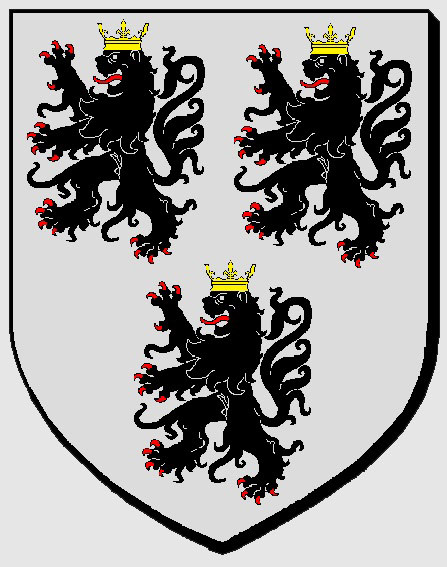
D'argent à trois lions de sable, armés et lampassés de gueules, couronnés d'or. Note: There are numerous branches of this family.
Here the mystery deepens because the arms representing the 'Cadet Branch of House of Halewijn-Lichtervelde, Lords of Lichtervelde' looks like this:
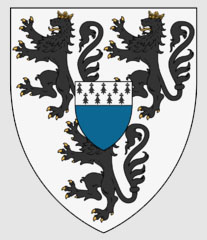
In this version the 'argent, three lions rampant sable' underlays the 'azure, a chief ermine' motif, except that the crowns and the claws are gold, the tongues are red. That is to say, the arms representing 'Daniel, Lord of Halluin' (or possibly 'Lucy') underlay the arms representing a branch of 'Halluin'. This is a case of a variation of a 'blason' wherein some alteration has been used to show a branch of a larger family —but what, if any, is the connection between these two entities? And is there a connection to 'Willem le Genne' whose 'blason' may simply be a variation of the Lichtervelde 'blason' wherein the crowns have been removed to show a different branch or some other relationship, such as locality. See also: An Heraldic Conundrum
source: http://wappenwiki.org/index.php/Gelre_Armorial_Folio_80
So, who is this guy??
As stated above, in the book "The Norman People", there is this reference to:
Ginn. N. and William Guenes, William Guenes or Guines of Normandy, 1180-98 (Magni Rotuli Scaccarii Normanniae); Osborne, Henry, William de Gene, England, c. 1272 (Rotuli Hundredorum ( reference @ Wikitree)). He may be an ancestor but there is no way to find a link to this man. The information is included to demonstrate how Coats of Arms are important and how they are used as a representation of an individual, or possibly a family or a place.
[ The Norman People, Anonymous; ie author name not stated, pg 274 (1874) ]
On 'The Dering Roll', we find 'William le Genne'
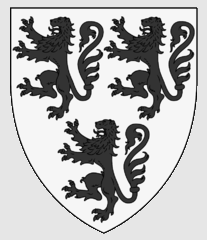
#34 Willem le Genne - Arms: Argent three lions rampant sable. This is similar to the blason for the village of Roncq (above) which the lions do not have crowns.
aka: William le Jone, who also appears in The Heralds' Roll, HE696 (d. 1310) (http://www.aspilogia.com/HE-Heralds_Roll/img/696.png)
aka: Willem le Jon.
Note: this blason is very similar to:
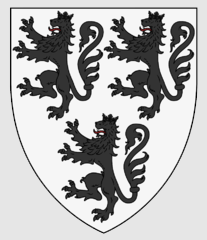
The arms of Halluin (see above) or The Lordship of Halluin except both of these have a crown, a red tongue and claws of gold and are described as: 'Argent, 3 lions sable langued gules, armed and crowned Or'.
There is no information available for 'The Lordship of Halluin' which appears to have been located in Belgium.
The blason also appears on '#26: Argent, three lions rampant sable (Cheverell)' from 1696
"Heraldic escutcheon above effigy and monument to Sir Amyas Bampfield (d.1626), All Saints Church, North Molton, Devon, England. Thirty quarterings. Similar 30 quarterings visible on funeral hatchment in Poltimore Church to Sir Coplestone Bampfylde, 2nd Baronet (d.1691)".
This same Coat of Arms appears on the Galloway Roll (Part 2):
# 170 Alexander de Cheverel; 'Argent three lions rampant sable' except with red tongue and claws.
This is an occasional roll dating from c 1300, during the campaigns of Edward I against the Scots. It is not precisely known to which occasion it refers, and may be incomplete. It probably refers to a skirmish which took place about three weeks after the siege of Caerlaverock. The manuscript is M14bis, pp376-90, College of Arms, London.
A similar blason appears for the village of D'Ans Freloux (Belgium)

described as: Per pale, 1st argent, three lions rampant sable, 2nd, argent 7 lozenges azure 3, 3 and 1 conjoined. Motto: nos prohibeo vulnero propinquo
see also: https://www.armorial.org/produit/3078/ans-de-freloux.html
See also: Jemeppe Castle
In Flemish Heraldry, 'Argent, three lions ... is used by Halewin
See: # 55, 56, 58, 60, 60 but are always 'armed or' which describes the gold claws.
Coat of Arms: Gand, Belgium

Described as: De sable a un lion d'argent languée de gueules, griffé et couronné d'or, portant au cou un collier avec une croix du même pendante sur sa poitrine.
GENT, Chapter 7, Flemish Nobility
blason - Ghendt (Van) dit Van Vaernewyck (ou de Grand dit Van Ghendt)
A similar blason appears on Gösenroth
Gösenroth is an Ortsgemeinde – a municipality belonging to a Verbandsgemeinde, a kind of collective municipality – in the Birkenfeld district in Rhineland-Palatinate, Germany. It belongs to the Verbandsgemeinde Herrstein-Rhaunen, whose seat is in Herrstein.

Described thusly: 'An endorse vert between Or a lion rampant sinister gules armed and langued azure, and argent three lions rampant sable'.
Side note: Cathedral Priory of Rochester – A history of the church was kept between 1315 and 1350, most likely by a notary named William de Gene. This passage shows the impact of the plague on societal structure:
A great mortality ... destroyed more than a third of the men, women and children. As a result, there was such a shortage of servants, craftsmen, and workmen, and of agricultural workers and labourers, that a great many lords and people, although well-endowed with goods and possessions, were yet without service and attendance......Such a shortage of workers ensued that the humble turned up their noses at employment, and could scarcely be persuaded to serve unless for triple wages. Instead, because of the doles handed out at funerals, those who once had to work now began to have time for idleness, thieving and other outrages, and thus the poor and servile have been enriched and the rich impoverished. As a result, churchmen, knights and other worthies have been forced to thresh their corn, plough the land and perform every other unskilled task if they are to make their own bread.(c.1349) (source: https://www.highwealdacademy.kent.sch.uk/_site/data/files/documents/curriculum/powerfulknowledge/Term%203%20and%204/6810552E276E134F296ADFB0718EFCD8.pdf)Another reference quotes the name of the chronicler as 'William de la Dene' or 'William Dene'
William de la Dene, Historia Roffensis,
(source: https://www.bl.uk/collection-items/a-firsthand-account-of-the-black-death-written-at-the-cathedral-of-rochester#)
In this context, the following are all examples that include uses of a 'lions rampant' motif. All of these examples are extracted from Wikipedia, except as noted.
Heraldic symbols with lions:
First, lets look at 'lions' in heraldic representation used by Royalty. Most of the time these are 'lions passant' but early on may occasionally be 'lions rampant'.
Arms of England at the time of Henry II show both 'lions rampant' and 'lions passant'. The 'lions passant' motif became the one used by British Royalty and is still used to this day.
 OR
OR 
Arms of England from 1154-1189-

Royal Arms of England (1189-1198)
Blazon description: Gules two lions combatant Or, armed and langued Azure.
Pourtant, au regard du sceau de Philippe d'Alsace, comte de Flandre, la thèse du lion rampant semble judicieuse; cf. supra. Mais la sigillographie seule ne permet pas de résoudre la question des couleurs: Gules, two lions passant guardant in pale or armed and langued azure, used as the inofficial "coat of arms of Normandy". Coat of arms attributed to "Arms of William the Conqueror (William I of England)"
Arms of Guillaume Plantagenêt, comte de Poitou

Fils de Geoffroy Plantagenêt, oncle de Richard Cœur de Lion. "Un lion". Sur un acte à Burghley. Ou peut-être comme comte du Poitou (Guillaume Plantagenêt, comte de Poitou @ myheritage.com)
Richard I of England: Richard the Lionheart (Cœur de Lion), comte d'Anjou et du Maine (1183), duc de Normandie (1189), duc d'Aquitaine et comte de Poitiers (1189-1196 et 1198-1199)
The second Great Seal of Richard I (1198) shows him bearing a shield depicting three lions passant-guardant. This is the first instance of the appearance of this blazon (french:blason), which later became established as the Royal Arms of England. It is likely, therefore, that Richard introduced this heraldic design. In his earlier Great Seal of 1189, he had used either one lion rampant or two lions rampants combatants, arms which he may have adopted from his father.
See also: Armorial of the House of Plantagenet and Richard the Lionheart's encounters with lions
The Kings of England only used the 'lions passant' aka 'lions passant-guardant' theme after Richard I.
Heraldic symbols with 'lions rampant':
Note: This is by no means a complete list. There are probably hundreds of examples of uses of 'lions rampant' in heraldic emblems. Some may have disappeared over time.
Armorial of the House of Plantagenet
The House of Plantagenet was the first truly armigerous royal dynasty of England. The arms of this noble, later royal, family, Gules, three lions passant guardant or (armed and langued azure), termed colloquially "the arms of England" signifying the "arms of the royal house of England", were first adopted by King Richard the Lionheart (1189–1199), son of King Henry II of England (1154–1189), son of Plantagenet founder, Geoffrey Plantagenet, Count of Anjou.
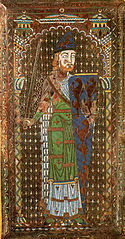
Enamel effigy of Geoffrey Plantagenet from his tomb at Le Mans.
His decorated shield suggests early origins of the three lions of the Royal Arms of England.
An enamel effigy (funerary plaque) commissioned by his widow to decorate the tomb of Geoffrey of Anjou is one of the earliest examples of European heraldry. Jean de Marmentier, a late-12th-century chronicler, reported that in 1128 Henry I of England knighted his son-in-law Geoffrey and granted him a badge of gold lions. A gold lion may already have been Henry's own badge, and different lion motifs would later be used by many of his descendants. The enamel shows Geoffrey with a blue shield depicting gold lions, apparently the same motif later used by a grandson of Geoffrey, William Longespee. In addition to being one of the first authentic representations of a coat of arms, according to British historian Jim Bradbury it "suggests possible evidence for the early use of what became the English royal arms".
Geoffrey V (24 August 1113 – 7 September 1151), called the Handsome, the Fair (French: le Bel) or Plantagenet, was the count of Anjou, Touraine and Maine by inheritance from 1129, and also the duke of Normandy by conquest from 1144. His marriage to Empress Matilda, daughter of King Henry I of England, led to the centuries-long reign of the Plantagenet dynasty in England. The name "Plantagenet" was taken from Geoffrey's epithet. Geoffrey's ancestral domain of Anjou gave rise to the name Angevin, and what became known as the Angevin Empire in the 12th century.

Arms of Longespée, as drawn by Matthew Paris (d. 1259): Azure, six lions rampant or, 3,2,1. As seen sculpted on the shield of his effigy in Salisbury Cathedral.
Note: The pattern on the inside of his cape is known as 'Vair' and is the motif used on the blason for the 'Comtes de Guînes'.
Geoffrey Plantagenet, Count of Anjou

Arms of Geoffrey of Anjou. Azure, six lions rampant Or armed and langued Gules, three, two and one.
The lion as a heraldic charge is present from the very earliest development of heraldry in the 12th century. One of the earliest known examples of armory as it subsequently came to be practiced can be seen on the tomb of Geoffrey Plantagenet, Count of Anjou, who died in 1151. An enamel, probably commissioned by Geoffrey's widow between 1155 and 1160, depicts him carrying a blue shield decorated six golden lions rampant and wearing a blue helmet adorned with another lion. A chronicle dated to c. 1175 states that Geoffrey was given a shield of this description when he was knighted by his father-in-law, Henry I, in 1128. (source: Lion Heraldry, Wikipedia)
Coat of arms of the Counts of Poitiers.

Blazon description: Argent a lion rampant gules.
- Arms of Richard of Cornwall, Earl of Cornwall
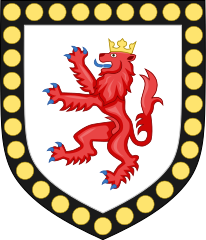

Richard of Cornwall, showing his arms; right his arms: Argent, a lion rampant gules crowned or a bordure sable bezantée as drawn by his contemporary Matthew Paris (d.1259)
Coat of arms of Flanders (Belgium, France and Netherlands) | Belgian Heraldry
The County of Flanders (Dutch: Graafschap Vlaanderen; West Flemish: Groafschap Vloandern; French: Comté de Flandre) was a historic territory in the Low Countries.
From 862 onwards the counts of Flanders were among the original twelve peers of the Kingdom of France. For centuries their estates around the cities of Ghent, Bruges and Ypres formed one of the most affluent regions in Europe. The Flemish lion derives from the arms of the Counts of Flanders. Their first appearance is on a seal of Count Philip of Alsace, dating from 1163. As such they constitute the oldest of the many territorial arms bearing a lion in the Low Countries.

English: Or a lion rampant sable armed and langued gules.
Français : D'or au lion de sable armé et lampassé de gueules.
A similar arms is used by Namur (province in Belgium)

Described as: D'or au lion de sable armé et lampassé de gueules, et couronné d'or, au baton de gueules brochant sur le tout: couronne comtale à treize perles dont trois relevées. and also the Flemish Community
Communes of Nord-France with 'lions rampant':
Nord-France. This region is by far the region where this design motif is most commonly used. At least 55 'communes' (villages) use it. The most obvious reason is because this region was once part of historic 'Flanders', an ancient kingdom that already existed at the time of the Norman Conquest. Geographically, Flanders included parts of France, half of Belgium, as well as parts of Holland. The number in brackets (59) refers to postal code for the region of Nord-France.
- Ansel de Garlande, seigneur en Brie, 1192

English: Ansel of Garlande (Brie, AD 1192); Français : Ansel de Garlande (Brie, AD 1192) Blazon description: English: Or a lion rampant gules Français : d'or au lion de gueules
Note: This description would be a red 'lion rampant' against a gold background similar to the blason of the town of Haussy or Râches as well as to the Flemish Community. (shown above) - Bambecque (Dutch: Bambeke) is a commune in the Nord department in northern France (59).

Blason de Bambecque Nord-France; "D'argent au lion de sable, armé et lampassé de gueules." - Note: Conon de Fiennes uses a very similar design. (geneanet.org) See also: Conan de Fiennes. A few generations later, one Guillaume Ii de Fiennes, baron de Tingry, Lord of Wendover uses a design which includes 'three lions sable' on an azure background. Sir Giles de Fiennes also uses 'three lions rampant or' on an azure background. See also: Seigneurs de FIENNES
- Bergues (French pronunciation: [bɛʁɡ]; Dutch: Sint-Winoksbergen; West Flemish: Bergn) is a commune in the Nord department in northern France (59).

Blason de la ville de Bergues Nord-France: "Parti : au 1, d'argent au lion contourné de sable, lampassé de gueules ; au 2, d'argent à une fasce de sable, et un franc-quartier d'or, bordé de gueules et chargé d'un lion de sable. " - Berthen

Blason de la ville de Berthen Nord-France: "D'or à la bordure d'azur, et en coeur un écusson d'argent, bordé d'azur et chargé d'un lion de gueules, armé, lampassé et couronné d'or." - Bissezeele

Blason de la ville de Bissezeele Nord-France: "D'or, au lion de sable, lampassé de gueules, couronné d'or, portant au cou un collier avec une croix du même pendante sur sa poitrine." - Blécourt, Nord

Blason de la ville de Blecourt Nord-France: "D'or à trois lions de sable. " - Bollezeele
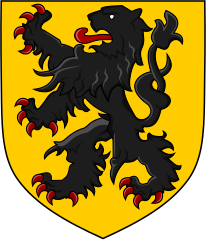
Blason: 'Or a lion rampant sable armed and langued gules'. Generic arms of Flanders. Also the arms of Département du Nord, Nord-Pas-de-Calais, Feignies, Flines-lez-Raches, Bollezeele , Wormhout and the Duchy of Jülich. - Broxeele
Broxeele (Dutch: Broksele) is a commune in the Nord department in northern France (59). It is 20 km (12 mi) south of Dunkirk and also 20 km (12 mi) west of the Belgian border.

Blason de la ville de Broxeele Nord-France: "De gueules au lion d'argent, armé et lampassé d'or. " - Brabant Lion

Brabant Lion held by Floris de Merode during the funeral of Albert VII, Archduke of Austria, print after design by Jacob Franquart. - Gers
Gers is a department in the Occitanie region of Southwestern France

Blason (non-officiel attendu que ce département ne revendique pas de blason) du département du Gers : d’argent au lion de gueules. Également blason de Erquéry (Oise, France). - Cantaing-sur-Escaut
Cantaing-sur-Escaut is a commune in the Nord department in northern France (59).

The arms of Cantaing-sur-Escaut are blazoned : Argent, 3 lions azure, armed and langed gules. - Capinghem
Capinghem (archaic Dutch: Campinghem) is a commune in the Nord department in northern France (59). It is part of the Métropole Européenne de Lille.

Blason de la ville de Capinghem Nord-France: "De sable au lion d'argent." - Chapter of Notre-Dame cathedral in Cambrai

Blazon: Français : D’or à trois lionceaux d’azur, au chef de gueules chargé d’une Notre-Dame-de-Grâce à mi-corps, de carnation, vêtue de gueules et d’azur et tenant l’Enfant Jésus à senestre. - Crochte
Crochte is a commune in the Nord department in northern France (59).

Blason de la ville de Crochte Nord-France: "D'argent au lion de sable." - Dourlers
Dourlers is a commune in the Nord department (district) of northern France (59).
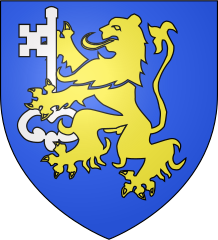
The arms of Dourlers are blazoned : Azure, a lion Or maintaining a key argent. (Dourlers, Pont-sur-Sambre and Rainsars use the same arms.) - Eccles
Eccles is a commune in the Nord department in northern France (59). It is about 15 km (9.3 mi) southeast of Maubeuge.

The arms of Eccles are blazoned : Argent, 3 lions gules, armed, langued and crowned Or. (Eccles, Nord and Villers-Sire-Nicole use the same arms.) - Éclaibes
Éclaibes is a commune in the Nord department in northern France (59).

The arms of Éclaibes are blazoned : Gules, 3 lions argent crowned Or. (Avesnes-les-Aubert, Éclaibes and Inchy use the same arms.) - Estrun
Estrun is a commune in the Nord department in northern France (59).

The arms of Estrun are blazoned : Or, 3 lions azure, on a chief gules, a demi-'Notre-Dame-de-Grâce de carnation' issuant from the line of division, vested gules and azure and holding in her left arm the Baby Jesus.
(Boursies, Cattenières, Carnières, Estrun, Maresches, Onnaing, Ors, Orsinval, Thun-l'Évêque and originally, Notre-Dame de Cambrai, use the same arms.) - Halluin
Halluin is a commune in the Nord department in northern France (59). Halluin is right on the border with Belgium, immediately north of Roncq,

The arms of Halluin are blazoned : Argent, 3 lions sable langued gules, armed and crowned Or. - The family of Halluin uses this same design:
A similar design is in the blason for the family of Halewyn (Halewijn, Flanders) (source: armorial.org) (see Roncq and So, who is this guy??) - Anne de HALLEWYN married to Hugues de FIENNES (Blason is the same whereas his father, Jean de FIENNES used only a single lion rampant sable, with a red tongue and no crown)
"Hugues de FIENNES, qui epousa Anne de HALLEWYN, dont les armes etaient: d'argent à trois lions de sable"
Their son, Henri de FIENNES, chevalier, seigneur du Bois dropped the name 'de FIENNES' and adopted the name 'du BOIS' with different arms. (pg226, 227) - Blason Daniel, Seigneur de Halluin (selon Gelre) is similar except crown is now black.

- Other armes with similar designs (geneanet)
- There is also the village of Halewijn ((Halewijnburg), near Ghent in Belgium. There are numerous places that use the name of 'Halewijn', especially in Holland.
- Halluin:

Description: D'argent à trois lions d'azur armés, lampassés et couronnés d'or.
Branche héritière au second degré du duché d'Halluin déplacée à Marchiennes. Le titre de Duc fut perdu lors du décès de Charles de Chomberg, Chevalier des ordres du roi, Pair et Maréchal de France et époux d'Anne d'Halluin. Dessin demandé par Jean-Réole Halluin. (FranceGenWeb) - Villers-Bretonneux
Villers-Bretonneux is a commune in the Somme department in Hauts-de-France in northern France.

Blason de la commune de Villers-Bretonneux, Somme, France : D'argent à trois lions de sable à la fleur de lys au pied nourri du même en cœur. - La famille d'Otreppe de Bouvette fut anoblie par l'impératrice Marie-Thérèse d'Autriche le 6 décembre 1738 en la personne de Théodore Dotreppe qui reçut en même temps une concession d'armoiries «d'argent à trois lions rampans de sable »
Ces armes étaient autrefois portées dès le XIIe siècle par la maison d'Otreppe et figurent comme telles dans Le miroir des nobles de Hesbaye - FREMIN du SARTEL; Place : Cambrai; Place : Nord, France
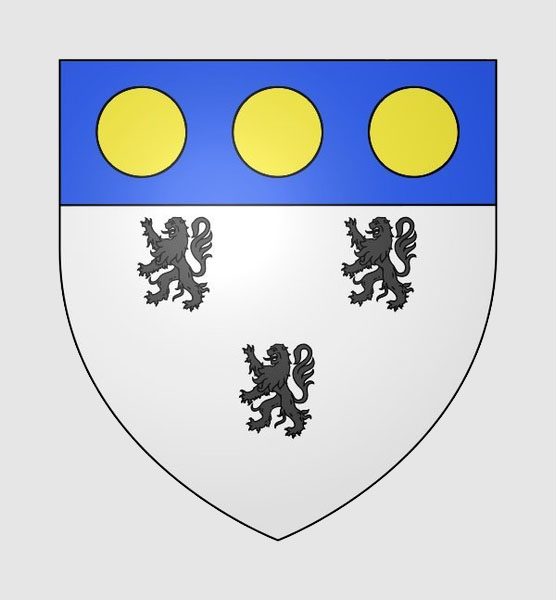
Heraldic Description : d argent à trois lions de sable 2 et 1 et un chef d azur chargé de trois besants d or - Note: most of these use 'lions rampant sable' (black) against a background which is 'argent' (silver).
- Last Name : de GAVARRET; Place : France
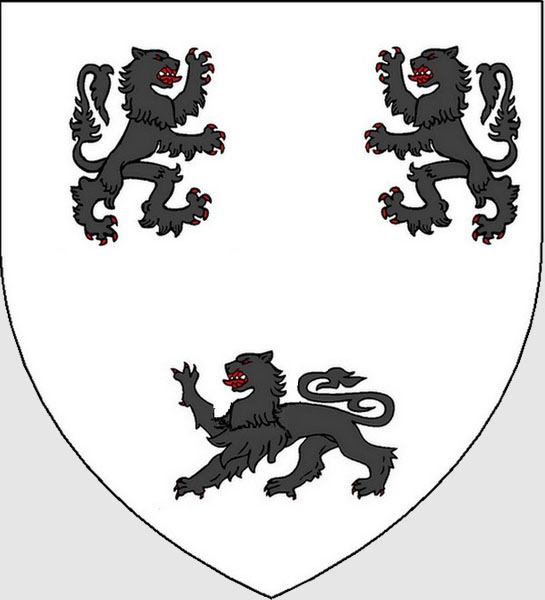
Heraldic Description : d’argent à trois lions de sable armés et lampassés de gueules, les deux du chef affrontés, le troisième passant en pointe - Blason: fr:Pierre le Bègue de Villaines, fr:Comte de Ribadéo

Blasonnement: D'argent, à trois lions de sable, armés et lampassés de gueules, au franc-quartier écartelé de Castille et de Léon. Références: Folio 50v de l'fr: Armorial de Gelre
Pierre de VILLAINES le Bègue (geneanet.org)
comte de Ribedieux (Ribadeo) (1369), de Tourny, de Vive Dieu, de Lanville, ...
See also: 440. Pierre de Villaines, dit le Bègue, Lord of Malicorne, Verneuil and Villaines, Count of Ribadeo, h' begge van vileynis (Gelre Armorial Folio 50, wappenwiki) - Haubourdin
Haubourdin is a commune in the Nord department in northern France (59). It is part of the Métropole Européenne de Lille.

The arms of Haubourdin are blazoned : Gules, a lion Or, armed, langued and crowned azure. (Aix-en-Pévèle, Emmerin, and Haubourdin use the same arms.) - Haucourt-en-Cambrésis
Haucourt-en-Cambrésis is a commune in the Nord department in northern France (59).

The arms of Haucourt-en-Cambrésis are blazoned : Argent billetty, a lion gules. (Bazenville, Haucourt-en-Cambrésis, Honnecourt-sur-Escaut and Sailly-lez-Cambrai use the same arms.) - Haulchin
Haulchin is a commune in the Nord department in northern France (59).

The arms of Haulchin are blazoned : Gules, a lion Or impaled with Azure semy de lys Or. - Haussy
Haussy is a commune in the Nord department in northern France (59).

The arms of Haussy are blazoned : Or, a lion gules. (Pont-l'Abbé, Escarmain and Haussy (see also Râches) use the same arms.) - Hazebrouck
Hazebrouck is a commune in the Nord department, Hauts-de-France (59).

The arms of Hazebrouck are blazoned : Argent, a lion sable langued gules, holding an inescutcheon Or charged with a 'coney courant bendwise proper'. - Honnecourt-sur-Escaut
Honnecourt-sur-Escaut is a commune in the Nord department in northern France (59).

The arms of Honnecourt-sur-Escaut are blazoned : Argent billetty, a lion gules. (Bazenville, Haucourt-en-Cambrésis, Honnecourt-sur-Escaut and Sailly-lez-Cambrai use the same arms.) - Hordain
 Hordain is a commune in the Nord department in northern France (59).
Hordain is a commune in the Nord department in northern France (59).
The arms of Hordain are blazoned : Or, a chief argent, overall a lion gules. (The emblazon here is actually Per fess argent and Or, a lion gules., which would make more sense.) - Inchy
Inchy is a commune in the Nord department in northern France (59). Jean-Gérard Fleury (1905–2002) French businessman, aviator, journalist and writer was born in Inchy.

Blason de la ville de Inchy Nord-France: "De gueules à trois lions d'argent couronnés d'or." - Jeumont
Jeumont is a commune lying on the Belgian border, located in the Nord department in northern France (59).

The arms of Jeumont are blazoned : Argent, 3 lions gules, overall a bend engrailed vert. - Killem
Killem is a commune in the Nord department in northern France (59).

The arms of Killem are blazoned : Argent, a lion sable, langued gules. (The arms of Bambecque, Killem and Maing are essentially the same) - La Longueville
La Longueville is a commune in the Nord department in northern France (59).

The arms of La Longueville are blazoned : Azure, billetty, a lion argent, armed and langued gules. (La Longueville, Templemars, and Verchain-Maugré use the same arms.) - Loon-Plage
Loon-Plage is a commune in the Nord department in northern France (59).

The arms of Loon-Plage are blazoned : Argent billetty, a lion sable armed and langued gules. (Loon-Plage and Spycker use the same arms.) - Louvignies-Bavay
Louvignies-Bavay is a former commune in the Nord department in northern France (59). In 1946 it was merged into Bavay.

The arms of Louvignies-Bavay are blazoned : Gules semy of billets, a lion argent langued gules. 
Blason de la ville de Lyon: De gueules au lion rampant, lampassé d'argent au chef d'azur chargé de trois fleurs de lys d'or- Philippe d'Alsace, comte de Flandre, 1162, 1177 et 1181

Armory of the county of Flanders (14th century)
Bien que les différents sceaux et contre-sceaux de Philippe d'Alsace représentent un lion soit rampant soit contourné, le blason au lion de Flandre n'a jamais été controversé, ce n'est pas le cas de celui de Richard Ier. cf. 1195 infra 
Poitou-Charentes coupé d'argent et de sable au lion de gueules, armé et lampassé d'azur, brochant sur le tout- Maing
Maing is a commune in the Nord department in northern France (59).

The arms of Maing are blazoned : Argent, a lion sable, crowned Or, armed and langued gules. (The arms of Bambecque, Killem and Maing are essentially the same) - Malincourt
Malincourt is a commune in the Nord department in northern France (59).

Blason de la ville de Malincourt Nord-France: "D'argent au lion de gueules, et un lambel à cinq pendants d'azur en chef." - Maresches
Maresches is a commune in the Nord department in northern France (59).

The arms of Maresches are blazoned : Or, 3 lions azure, on a chief gules, a demi-'Notre-Dame-de-Grâce de carnation' issuant from the line of division, vested gules and azure and holding in her left arm the Baby Jesus. (Boursies, Cattenières, Carnières, Estrun, Maresches, Onnaing, Ors, Orsinval, Thun-l'Évêque and originally, Notre-Dame de Cambrai, use the same arms.) - Mathieu III, comte de Beaumont-sur-Oise, 1189

English: early earl of Beaumont-sur-Oise (1189-1223) Français : premiers seigneurs de Beaumont-sur-Oise (1189-1223) Blazon description: English: azur a lion or alias gules a lion argent Français : d'azur au lion d'or alias de gueules au lion d'argent - Maubeuge
Maubeuge (historical Dutch: Mabuse or Dutch: Malbode) is a commune in the Nord department in northern France (59).

The arms of Maubeuge are blazoned : Or, 4 lions, 2 in bend sable armed and langued gules, 2 in bend sinister gules armed and langued azure, in chief an eagle sable beaked langued membered and armed gules, overall a crozier Or bendwise. - Maurois
Maurois is a commune in the Nord department in northern France (59).

The arms of Maurois are blazoned : Azure, a lion argent within a bordure Or. (Maurois and Montigny-en-Cambrésis use the same arms.) - Montigny-en-Cambrésis
Montigny-en-Cambrésis is a commune in the Nord department in northern France (59).

The arms of Montigny-en-Cambrésis are blazoned : Azure, a lion argent within a bordure Or. (Maurois and Montigny-en-Cambrésis use the same arms.) - Nord (French department) or Nord-Pas-de-Calais
Nord-Pas-de-Calais is a former administrative region of France.
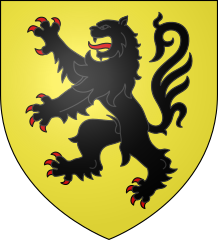
Heraldic symbol described as: Or a lion rampant sable armed and langued gules. (French: D'or au lion de sable armé et lampassé de gueules.)
According to Wikipedia, a similar symbol was used by Henri Le Lion, duc de Saxe described as 'équestre, l'écu au lion' (1144). Nearly identical to arms motif used by Flanders, Belgium. - Onnaing
Onnaing is a commune in the Nord department in northern France (59).

The arms of Onnaing are blazoned : Or, 3 lions azure, on a chief gules, a demi-'Notre-Dame-de-Grâce de carnation' issuant from the line of division, vested gules and azure and holding in her left arm the Baby Jesus. (Boursies, Cattenières, Carnières, Estrun, Maresches, Onnaing, Ors, Orsinval, Thun-l'Évêque and originally, Notre-Dame de Cambrai, use the same arms.) - Orchies
Orchies is a commune in the department of Nord in the Hauts-de-France region of northern France (59). Orchies is the biggest town of the Pévèle. It is especially known for its Musée de la chicorée, the museum of chicory. Orchies is twinned with Kelso in the Scottish Borders area of the United Kingdom.
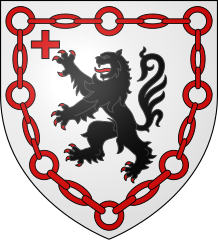
Blason de la ville de Orchies Nord-France: "D'argent au lion de sable armé et lampassé de gueules, regardant une croisette du même en chef, le tout entouré d'une chaîne de gueules mise en orle." - Pont-sur-Sambre
Pont-sur-Sambre is a commune in the Nord department in northern France (59).

The arms of Pont-sur-Sambre are blazoned : Azure, a lion Or maintaining a key argent. (Dourlers, Pont-sur-Sambre and Rainsars use the same arms.) - Quaëdypre
Quaëdypre (Dutch: Kwaadieper) is a commune in the Nord department in northern France (59).
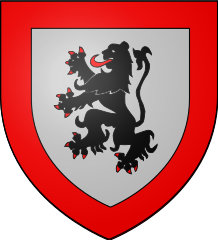
Blason de la ville de Socx Nord-France: "D'argent au lion de sable armé et lampassé de gueules à la bordure de gueules" - Râches
Râches is a commune in the Nord department in northern France (59).

The arms of Râches are blazoned : Or, a lion gules, armed and langued azure. (cf Pont-l'Abbé, Escarmain and Haussy) - Rainsars
Rainsars is a commune in the Nord department in northern France (59).

The arms of Rainsars are blazoned : Azure, a lion Or maintaining a key argent. (Dourlers, Pont-sur-Sambre and Rainsars use the same arms.) - Ribécourt-la-Tour
Ribécourt-la-Tour is a commune in the Nord department in northern France (59).

The arms of Ribécourt-la-Tour are blazoned : Vert, a lion Or, armed and langued gules. (Ribécourt-la-Tour and Robersart use the same arms.) - Robersart
Robersart is a commune in the Nord department in northern France (59).

The arms of Robersart are blazoned : Vert, a lion Or, armed and langued gules. (Ribécourt-la-Tour and Robersart use the same arms.) 
Roger de Meulan, vicomte d'Évreux jusqu'en 1204, seigneur d'Aubergenville du fait de sa femme. Il est attesté comme seigneur de la Queue-en-Brie, Gournay, Chennevières et Sucy1, il décède après 1205.
!-- https://fr.wikipedia.org/wiki/Roger_de_Meulan#/media/Fichier:Sceau_Roger_de_Meulan_1197_Fig_242_p194.jpg --> English: Bernay (Normandy) Français : la ville de Bernay (Eure) d'après Malte-Brun
Blazon description: English: Gules a lion argent. Français : De gueules, au lion grimpant d'argent.
DA no 2834. Dès 1195, son 1er sceau non héraldique porte un lion au naturel passant contourné (DA no 2833)34,N. 14 Les couleurs sont hypothétiques mais plausibles puisque identiques à celle de son beau-frère Simon III de Montfort, comte d'Évreux, ainsi qu'aux anciennes armes de la ville de Bernay dans l'Eure.
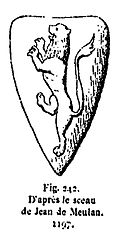
Sceau (Seal) de Roger de Meulan, 1197, vicomte d'Évreux jusqu'en 1204, seigneur d'Aubergenville du fait de sa femme. Attesté comme seigneur de la Queue-en-Brie, Gournay, Chennevières et Sucy-en-Brie,- Roncq (See Halluin)
Roncq commune in the Nord department in northern France (59).

The arms of Roncq are blazoned : Argent, 3 lions sable armed and langued gules.
"Roncq relève les armes de la famille D'Halluin (ou D'Halewyn), qui donna les seigneurs du lieu au XVIe siècle. Ces armes sont également portées par la commune d'Halluin , à la différence que les lions de Roncq ont abandonné sur la tête des lions, les couronnes des armes familiales. Théodore Leuridan cite ces armes dans son Armorial des communes du Nord, 1909. (Jacques Dulphy)" ( source: https://armorialdefrance.fr/page_blason.php?ville=14588) - Rubrouck
Rubrouck (Dutch: Rubroek, once Ruysbroeck) is a commune in the Nord department in northern France (59).

The arms of Rubrouck are blazoned : Gules, a lion argent armed and langued Or. (Broxeele and Rubrouck use the same arms.) - Sailly-lez-Cambrai
Sailly-lez-Cambrai is a commune in the Nord department in northern France (59).

The arms of Sailly-lez-Cambrai are blazoned : Argent billetty, a lion gules. (Bazenville, Haucourt-en-Cambrésis, Honnecourt-sur-Escaut and Sailly-lez-Cambrai use the same arms.) - Sancourt, Nord
Sancourt is a commune in the Nord department in northern France (59).

The arms of Sancourt are blazoned : Azure, a lion Or. - Santes
Santes is a commune in the Nord department in northern France (59). It is part of the Métropole Européenne de Lille.

The arms of Santes are blazoned : Argent, 3 lions vert, langued gules. - Sercus
Sercus is a commune in the Nord department in northern France (59).

The arms of Sercus are blazoned : Argent, a lion contourny sable, in chief a label of 3 points gules. - Socx
Socx (French pronunciation: [sɔks]; from Flemish; Soks in modern Dutch spelling) is a commune in the Nord department in northern France (59).

The arms of Socx are blazoned : Argent, a lion sable armed and langued within a bordure gules. (Quaëdypre and Socx use the same arms.) - Sommaing
Sommaing is a commune in the Nord department in northern France (59).

The arms of Sommaing are blazoned : Argent, a lion gules within a bordure engrailed azure. - Spycker
Spycker is a commune in the Nord department in northern France (59).

The arms of Spycker are blazoned : Argent billetty, a lion sable armed and langued gules. (Loon-Plage and Spycker use the same arms.) - Templemars
Templemars is a commune in the Nord department in northern France (59).
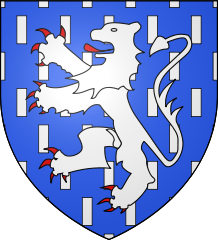
The arms of Templemars are blazoned : Azure, billetty, a lion argent, armed and langued gules. (La Longueville, Templemars, and Verchain-Maugré use the same arms.) - Thiant
Thiant is a commune in the Nord department in northern France (59).

The arms of Thiant are blazoned : Vert, billetty, a lion argent, armed and langued gules. (Thiant and Aubry-du-Hainaut use the same arms.) - Thun-l'Évêque
Thun-l'Évêque is a commune in the Nord department in northern France (59).

The arms of Thun-l'Évêque are blazoned : Or, 3 lions azure, on a chief gules, a demi-'Notre-Dame-de-Grâce de carnation' issuant from the line of division, vested gules and azure and holding in her left arm the Baby Jesus. (Boursies, Cattenières, Carnières, Estrun, Maresches, Onnaing, Ors, Orsinval, Thun-l'Évêque and originally, Notre-Dame de Cambrai, use the same arms.) - Valenciennes
Valenciennes is a commune in the Nord department in northern France (59).

The arms of Valenciennes are blazoned : gules a lion or armed and langued azure - Verchain-Maugré
Verchain-Maugré (in the Middle Ages, Werchin) is a commune in the Nord department in northern France (59). Between 1383 and 1415, the poet and renowned jouster Jean de Werchin was the lord of Werchin.

The arms of Verchain-Maugré are blazoned : Azure, billetty, a lion argent, armed and langued gules. (La Longueville, Templemars, and Verchain-Maugré use the same arms.) - Villers-Sire-Nicole
Villers-Sire-Nicole is a commune in the Nord department in northern France (59).
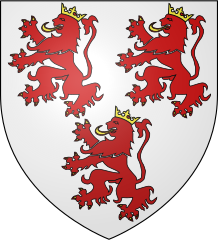
The arms of Villers-Sire-Nicole are blazoned : Argent, 3 lions gules, armed, langued and crowned Or. (Eccles, Nord and Villers-Sire-Nicole use the same arms.) - Walincourt
Walincourt is a former commune in the Nord department in northern France (59), merged in October 1972 with Selvigny to create Walincourt-Selvigny

The arms of Walincourt are blazoned : Argent, a lion gules. (the Counts of Armagnac and the communes of Walincourt, Humerœuille, La Roche-Derrien, Sornac, Espelette, Gigean, Médis and Erquery use the same arms.) - Wattrelos
Wattrelos is a commune in the Nord department in the Nord-Pas de Calais region of northern France (59). It is located on the border with Belgium, northeast of the city of Lille.

The arms of Wattrelos (Nord, France) are blazoned : Azure, a lion barry argent and gules armed langued and crowned - Wormhout
Wormhou is a commune in the Nord department in northern France (59). Several people in Wormhout still speak Flemish, a local dialect of Dutch and the traditional language of the region, while French-speakers form a majority, due to centuries of French political and cultural influence. The town's name is of Germanic origin, meaning "Wormwood.

The arms of Wormhout are blazoned : Or, a lion sable armed and langued gules. ('Flanders' and the communes of Thourotte, Crépy-en-Valois, Bollezeele, Feignies, Flines-lez-Raches and Wormhout use the same arms.) - A symbol simply described as "un lion, écu" was used by Guelf VI, duc de Toscane, frère de Henri X de Bavière in 1152
Armorial of the Communes of Nord: (A–C) | (D–H) | (I–P) | (Q–Z)
Complete lists of Nord armorial pages. Numerous entities use the 'lions rampant' motif.
Other regions of France: (Number of blasons with 'lions'; most don't specify 'rampant' even when they are)
- 14 Calvados (14)
- Creully
Creully is a former commune in the Calvados department in the Normandy region in northwestern France.

The arms of Creully are blazoned : Argent three lions gules - 16 Charente (5)
- 17 Charente-Maritime (7)
- Dordogne
Dordogne is a department in Southwestern France, with its prefecture in Périgueux.

English: Gules three lions rampant or armed langued and crowned azure. Français : De gueules aux trois lions d’or couronnés, armés et lampassés d’azur. - 27 Eure (15)
- 28 Eure-et-Loir (1)
- 35 Ille-et-Vilaine (9)
- Cherrieux

D'argent au lion de sable. - 49 Maine-et-Loire (3+)
- 50 Manche (4)
- 60 Oise
- Oise: A–C (8)
- Oise: D–H (3)
- Oise: I–P (12)
- Coat of arms of Maignelay-Montigny
Maignelay-Montigny is a commune in the Oise department in northern France

Blason de la commune de maignelay-montigny oise france : double écu 1) de gueules à la bande d'or 2) d'argent au trois lion de sable lampassé de gueules et couronné d'or - Blason de Maignelay-Montigny
Le blason des Tristan à gauche, le blason des d'Halluin à droite - Oise: Q–Z (1)
- 61 Orne (9)
- 62 Pas-de-Calais
- 76 Seine-Maritime (15)
- 85 Vendée (9)
- 93 Seine-Saint-Denis (2)
Armorial des familles de Bretagne
Numerous examples of 'lions rampant' in use although they may be described differently.
See also: Coat of arms of the Netherlands and Coat of arms of Luxembourg
See also: History of the Counts of Harnes by Mike Clark, PhD.
Arms described as 'gold rampant lion on a red field'. The design is very similar to the blason for Valenciennes.
Notes from: A Treatise On Heraldry British And Foreign By Woodward, Burnett, V1, 1892
In our own country mutations of arms were by no means in frequent, as in the case of the FERRERS, Earls of DERBY; and a noble marrying a lady of higher position, or greater possessions, usually assumed her arms. (pg 52)
The earliest seal of a Count of Flanders given by VREE, in his work 'De Seghelen der Gravenvan Vlaendren', which bears a shield charged with the lion of Flanders is that of Count ROBERT on plate 4, attached to a charter of 1072. (pg 47)
the black lion of Flanders (pg 58)
Argent, three lions rampant gules, crowned azure is the coat of BARBANCON.
Argent, three lions rampant sable, is used by CHEVERELL in England, and with the lions crowned or, by HALEWIJN of Flanders (Armorial de Gueldre). (See: Halluin)
Gules, three lions rampant or, was the coat of Prince TALLEYRAND-PERIGORD. (pg 223)
CHAPTER VII. ANIMATE CHARGES: II. BEASTS. I.THE LlON.
No animal has anything like so prominent a position in early, and even in later heraldry, as that which is held by the Lion. The earliest known example of it is on the seal of PHILIP I., Count of FLANDERS, appended to a document of 1164 (pg 208)
see pages 208 - 217
Or, a lion rampant sable (d'Or, au lion de sable) is the well known coat of the Counts of FLANDERS (pp.483);
Or, a lion rampant gules (d'Or, au lion de gueules) is the blazon of the Counts of HOLLAND, and the original coat of the Counts of HAPSBURG,
Argent, a lion rampant azure (d'Argent, au lion d'azure) is the coat of the CRICHTONS of Frendraught; of the BRUGES, and FAUCONBERGES, or FALCONBRIDGES; and of the Counts MENSDORFF-POUILLY of Austria. (pg 208 - 212)
see image pg 213
Argent, a lion rampant gules (d'Argent, au lion de gueules) is borne by the Counts of ARMAGNAC in France; theBarons of WARTENBERG (Wappenrolle von Zurich, No.191), the Counts von ALTDORF; the PREISSACS, Dues de FlMARGON, and D'ESCLIGNAC in France; and by the family of FEZENSAC (Salle des Croises, 1097)
Argent, a lion rampant sable (d'Argent, au lion de sable), are the arms of STAPLETON, and FlTZROGER in England, the Welsh families of LLOYD; MORGAN; WYNN, etc., the Counts BARBARANI, and LOREDAN of Venice, the Barons BERSTETT of Austria, the French families of FlENNES, and POLASTRON (both in the Salle des Croises, thirteenth century), etc
... more ... (pg 213 - 217)
source: https://ia802701.us.archive.org/29/items/treatiseonherald00wooduoft/treatiseonherald00wooduoft.pdf
Heraldry Sites
Armorial des familles de France
Bibliographie. Sources : * H. GOURDON de GENOUILLAC : Recueil d'armoiries des maisons nobles de France. E. Dentu, Éditeur. Paris. 1860.
British Armorial Bindings, U Toronto
British Heraldry Bookshelf by Karl Wilcox
Armorial de Rietstap (Wikipedia)
COATS-OF-ARMS-HERALDRY.COM All about heraldry
French Heraldry
The French system of heraldry greatly influenced the British and Western European systems. Much of the terminology and classifications are taken from it.
Gelre Armorial (Wappenwiki)
Heraldry Portal
Heraldry encompasses all of the duties of a herald, including the science and art of designing, displaying, describing and recording coats of arms and badges, as well as the formal ceremonies and laws that regulate the use and inheritance of arms. The origins of heraldry lie in the medieval need to distinguish participants in battles or jousts, whose faces were hidden by steel helmets.
Heralds Network
Host of: Saitou's online adaptation of A Glossary of Terms Used in Heraldry, by James Parker.
A GLOSSARY OF TERMS USED IN HERALDRY, by JAMES PARKER, FIRST PUBLISHED in 1894
L'Armorial
Le site des blasons des villes et des villages de France
List of oldest heraldry
Heraldry developed in the High Middle Ages (c. 1000-1250), based on earlier, "pre-heraldic" or "ante-heraldic", traditions of visual identification by means of seals, field signs, emblems used on coins, etc. Notably, lions that would subsequently appear in 12th-century coats of arms of European nobility have pre-figurations in the animal style of ancient art (specifically the style of Scythian art as it developed from c. the 7th century BC).
Liste de blasons d'après les sceaux du XIIe siècle
Nord (département 59) @ Linternaute.com (Villes > Hauts-de-France)
WappenWiki
WappenWiki deals with heraldry, here you will find standardized coat of arms of countries in medieval Europe, Anatolia and the Holy Land. Coat of arms throughout Europe, Anatolia, the Holy Land & the New World, from about 1100 and onwards.
